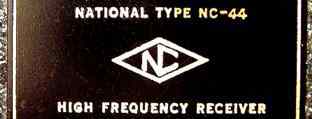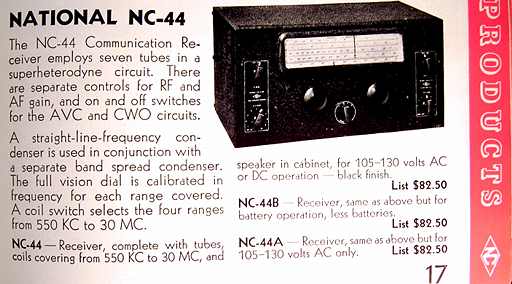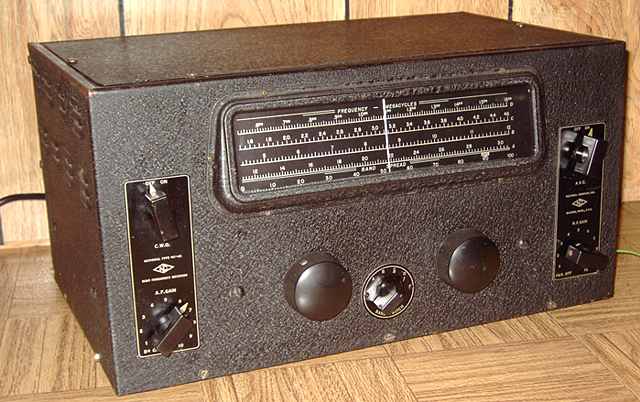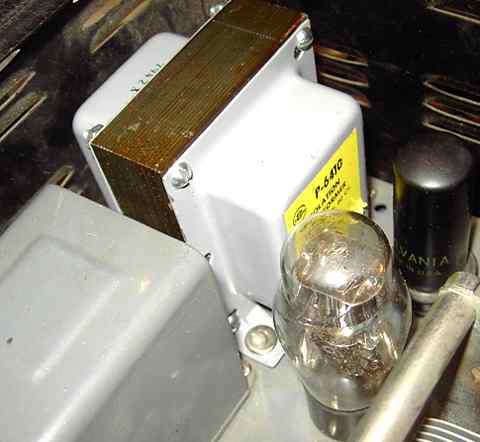


As described in this ad from the 1941 ARRL Handbook, the NC-44 receiver is AC-DC. The NC-44A has the same tube complement but is AC-only. The NC-44B is a battery-operated version that substitutes a 6V6 for the 25L6 and, of course, eliminates the 25Z5. Note that all three have the same price $82.50. That surprised me since the NC-44A has an added isolation transformer not found in the NC-44. The added transformer would have been an extra-cost item. This leads me to believe that National came out with the NC-44 not just as a low-cost set but also to meet the needs of those who might only have had access to 120 volts DC, a not-uncommon occurrence in 1938 in certain sections of New York City and isolated areas of the country, as well as aboard many ships.
The 1941 price of $82.50 can be compared to a price of $44.50 in an ad in the February 7, 1939 issue of "The Tech", the newspaper for MIT, from Boston dealer H. Jappe Company. Inflation must have been high in the 1939 to 1941 time frame.
Schematics for the three NC-44 versions can be found in Rider volume 14, National page 11 to 13. A copy can be found on BAMA.

Condition
The cosmetic condition of this set was excellent and very clean as purchased. The exterior was unmodified. However, the chassis had been modified somewhat in its lifetime. The three IF transformers had been replaced with nice black-wrinkle Meissner units. An extra hole, possibly for a tube socket, was very neatly placed between existing tubes. That hole turned out to be a perfect fit for a replacement electrolytic.
Repairs
Contact cleaner was applied to the tube sockets and controls. The AVC switch appeared to be broken. I removed it, repaired it by reseating a popped rivet and re-installed it. I found the RF gain control to be open even after application of deoxit. I removed the control, opened it, and cleaned the lower slider contact by direct application of contact cleaner for a successful repair. I also replaced several capacitors.
The cathode bypass electrolytic on the 25L6 tube had been wired in backwards. When removed and tested, the cap was surprisingly still good. However, I replaced it anyway. The cathode resistor had drifted in value to 200 ohms. It was also replaced.
Modifications to solve the hot-chassis problem
By design, the NC-44 is AC-DC capable. One side of the power line is switched directly to the chassis. The NC-44A, as noted above, was available with an isolation transformer built-in and was offered at the same price. The factory NC-44 chassis has the holes and the space ready to place that isolation transformer. For safety, I decided to upgrade the NC-44 to add an isolation transformer if I could locate one to fit the factory mounting holes. Thanks to a junque-box parts swap via NC8V, a Stancor P-6410 isolation transformer was located that readily fit those holes. I modified the transformer shells to re-route the wiring directly to the chassis holes below the mount. The original power cord was two wire with both sides fused. That cord was replaced with a modern three wire version with a single fuse in the hot leg only.

More modifications
The original NC-44 had no output transformer on the chassis. Instead, its sends B+ and the output tube plate connection directly to exposed and accessible pin jacks on the rear of the chassis. I again modified the set in the interest of safety, mounting an output transformer below the chassis using existing mounting bolts. I also cut the B+ wiring to an exposed terminal strip used for remote standby operation. Note that all of my modifications are readily reversible and added no new holes to the set. All were done with the intention of eliminating exposed shock hazards.
Performance
The NC-44 after repairs (and modifications) performed as well as expected for a set with two IF stages but no RF stage. Mechanically, its variable capacitors are very well designed and the set is quite stable. With a proper antenna, it is useful for short-wave and broadcast band listening as well as casual use on the lower ham bands. I consider it to be a very handsome black wrinkle set.
Update and correction
Sharp eyed DeWitt N4QNX caught an error in my original writeup. Apparently I used the battery model resistor list to determine the value of the 25L6 cathode resistor. The actual cathode resistor for the NC-44 should be 140 ohms. Thank you Dewitt.
An Ameco CPS Deluxe Code Practice Oscillator was the previous item on the bench.